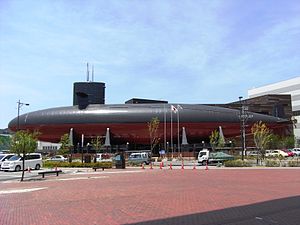Akishio (SS-579)

JDS Akishio at the Kure Naval Museum.
|
|
| History | |
|---|---|
|
|
|
| Name: | Akishio |
| Builder: | Mitsubishi Heavy Industries |
| Laid down: | 15 April 15 1983 |
| Launched: | 22 January 1985 |
| Commissioned: | 5 March 1986 |
| Decommissioned: | 3 March 2004 |
| Identification: | SS-579 |
| Fate: | On display at the JMSDF Kure Museum since 2007 |
| General characteristics | |
| Class and type: | Yūshio-class submarine |
| Displacement: | 2,250 tonnes (2,210 long tons; 2,480 short tons) (Surface), 2,450 tonnes (2,410 long tons; 2,700 short tons) (Submerged) |
| Length: | 76.2 m (250.0 ft) |
| Beam: | 9.9 m (32.5 ft) |
| Draught: | 10.2 m (33.5 ft) |
| Propulsion: |
|
| Speed: |
|
| Test depth: | 300 m (980 ft) |
| Complement: | 75: 10 officer, 65 enlisted |
| Sensors and processing systems: |
|
| Armament: | 6 × 21 in (533 mm) torpedo tubes |
Akishio (SS-579) was a Japanese diesel-electric Yūshio-class submarine. She was laid down in 1983, launched in 1985, commissioned in 1986, and served until 2004. She served as part of both the 1st and 5th Submarine Squadrons of the 1st Submarine Flotilla. She took part in numerous drills, including the Pacific Reach 2000 drills. She is now on display outside Kure Maritime Museum.
Akishio was 76.2 metres (250 ft) long, had a beam 9.9 metres (32 ft) wide, had a draught of 10.2 metres (33 ft) and displaced 2,250 tonnes (2,210 long tons; 2,480 short tons) while surfaced, and 2,450 tonnes (2,410 long tons; 2,700 short tons) when submerged. She had a teardrop hull, and was powered by two Kawasaki-MAN V8V24/30AMTL diesel engines, which produced 3,400 brake horsepower (2,500 kW), a Fuji electric motor, which produced 7,200 shaft horsepower (5,400 kW), and was propelled by one shaft, with a five-bladed propeller. She used her diesel engines while surfaced, and her electric motor when submerged. She had a top speed of 12 knots (22 km/h; 14 mph) while surfaced, and 20 knots (37 km/h; 23 mph) while submerged. She was armed with six 21-inch (533 mm) torpedo tubes, and had a complement of 75: 10 officers and 65 enlisted men. She had a test depth of 300 metres (980 ft). She used a Hughes/Oki ZQQ 5 hull mounted sonar, and a ZQR 1 towed array sonar.
...
Wikipedia
